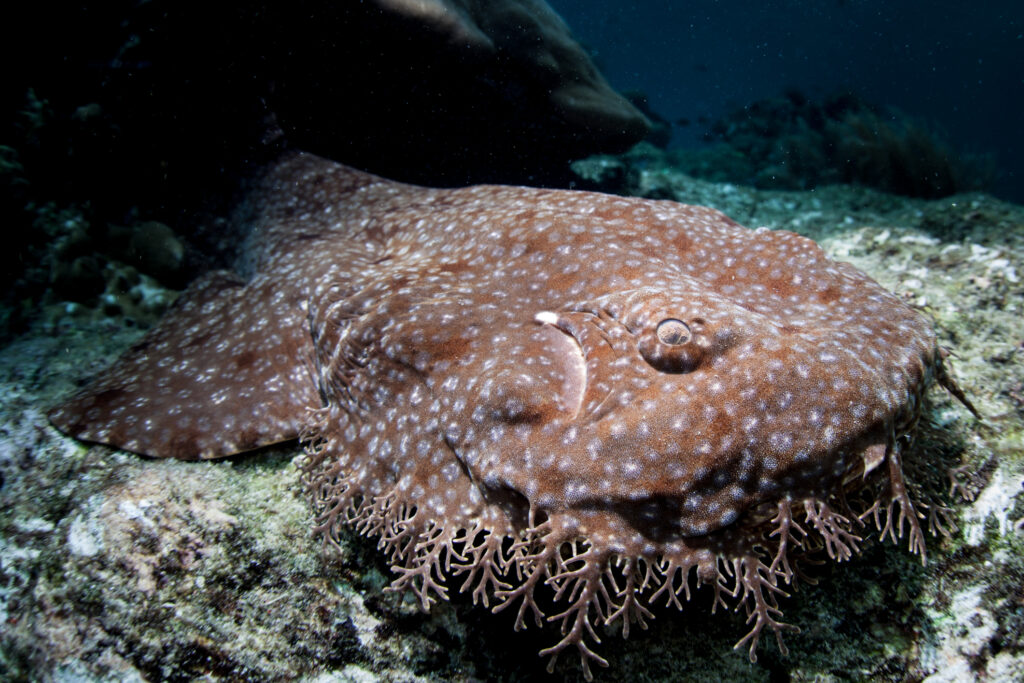Sharks are some of the most diverse and fascinating creatures in the ocean, with over 500 species swimming through our waters. From the gigantic whale shark to the tiny dwarf lantern shark, they come in all shapes and sizes.
Among this incredible family, carpet sharks have some truly unique features and behaviours that set them apart. Let’s dive into the world of carpet sharks and uncover some intriguing facts about these remarkable animals.
What is a carpet shark?
So, what exactly is a carpet shark? Belonging to the order Orectolobiformes, these sharks include around 40 species split into seven families. They stand out due to their distinctive appearance and habits. Unlike the stereotypical sleek, fast-moving shark, carpet sharks tend to be more laid-back and have intricate patterns that help them blend into their surroundings. Their body shape is very different too, as they are benthic sharks. This means their body shape is wider than other shark species.
6 facts about carpet sharks
1. Some carpet sharks are also known as wobbegongs
Here’s a fact that’s definitely fun to say: some carpet sharks are also known as wobbegongs. The name “wobbegong” is believed to come from an Australian Aboriginal word meaning “shaggy beard.” When you see one at Blue Planet Aquarium, you’ll get it instantly – they have fringed, beard-like features around their mouths. These barbels and dermal flaps not only make them look unique but also help them sense their environment and stay hidden. Whale sharks are closely related to Orectolobiformes.

2. They live mostly in the Pacific and Indian Oceans
You’ll mostly find carpet sharks in the Pacific and Indian Oceans. Their habitats can be quite varied, though. For instance, the spotted wobbegong (Orectolobus maculatus) is found only in Australian waters, while the Arabian carpet shark (Chiloscyllium arabicum) hangs out around coral reefs in the Arabian Sea. Generally, they prefer shallower waters with warm, tropical temperatures. Coastal areas are their playground.
3. They can camouflage against the sea floor
Carpet sharks are masters at blending in with the sea floor. Wobbegongs’ intricate patterns and colours mimic the seabed, helping them hide from both predators and prey. These champion hide-and-seek players are so effective at using their camouflage that they can be almost invisible even when lying out in the open. Arabian and brown branded bamboo sharks have bands or spots that can help them to camouflage.
4. Some are ambush predators
When it comes to hunting, most carpet sharks use a different strategy compared to the fast-moving predators we usually picture. They are ambush predators, meaning they lie in wait for their prey.
Hidden among rocks or coral, they wait for an unsuspecting fish or invertebrate to come close before they strike. Their diet mainly includes fish, crustaceans, and small octopuses. Some species have even been known to snack on other sharks. Sneaky, but effective!
However some other species of carpet shark, like the bamboo shark, actively hunt instead, while whale sharks don’t hunt at all but instead filter feed.
5. They can’t see that well
Carpet sharks are nocturnal animals, meaning they sleep during the day and become more active at night. Because of this, they don’t rely heavily on their eyesight and have therefore developed other senses more acutely such as their sense of smell. Carpet sharks also have electro sense too, thanks to the ampullae of Lorenzini which are electric sensing cells located in their barbel.
It is often found with animals that are frequently in the dark that their eyesight will be slowly phased out of the gene pool, such as with the Blind Cave Fish.
6. Different species reproduce in different ways

Reproduction in carpet sharks varies from species to species. Some give birth to live young (viviparous), while others lay eggs that hatch inside the mother (ovoviviparous). Take the tasselled wobbegong, for example. This species is ovoviviparous, with embryos developing in egg cases inside the mother’s body until they’re ready to hatch. This just goes to show how diverse life strategies can be, even within the same group of animals.
Carpet sharks are a captivating group with unique adaptations that set them apart. From their impressive camouflage skills to their ambush-hunting techniques, these sharks play a crucial role in their ecosystems. If you find these creatures as intriguing as we do, you might want to see them up close at an aquarium.
Book your tickets to Blue Planet Aquarium, where you can find the Western wobbegong and the spotted wobbegong, offering just a glimpse into the diversity and wonder of the carpet shark family.
